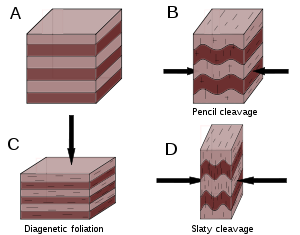
Back Klivaj Azerbaijani Kliváž Czech Clivaje (geología) Spanish Lõhelisus Estonian विदलन (भूविज्ञान) Hindi Կլիվաժ Armenian Belahan (geologi) ID Clivaggio (geologia) Italian კლივაჟი Georgian Кливаж Kazakh

Cleavage, in structural geology and petrology, describes a type of planar rock feature that develops as a result of deformation and metamorphism.[1] The degree of deformation and metamorphism along with rock type determines the kind of cleavage feature that develops. Generally, these structures are formed in fine grained rocks composed of minerals affected by pressure solution.[1]
Cleavage is a type of rock foliation, a fabric element that describes the way planar features develop in a rock. Foliation is separated into two groups: primary and secondary. Primary deals with igneous and sedimentary rocks, while secondary deals with rocks that undergo metamorphism as a result of deformation. Cleavage is a type of secondary foliation associated with fine grained rocks. For coarser grained rocks, schistosity is used to describe secondary foliation.
There are a variety of definitions for cleavage, which may cause confusion and debate. The terminology used in this article is based largely on Passchier and Trouw (2005). They state that cleavage is a type of secondary foliation in fine grained rocks characterized by planar fabric elements that form in a preferred orientation. Some authors choose to use cleavage when describing any form of secondary foliation.
- ^ a b Passchier, C. W.; Trouw, R. A. J. (2005). Microtectonics. Springer. p. 366. ISBN 9783540640035.
© MMXXIII Rich X Search. We shall prevail. All rights reserved. Rich X Search